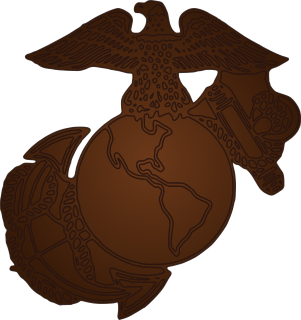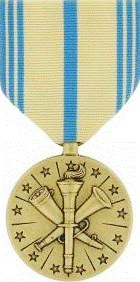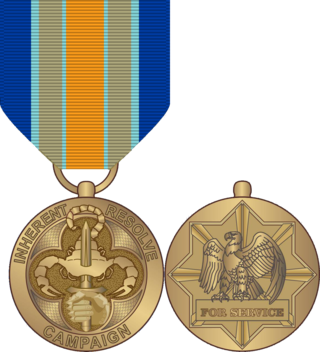The Commendation Medal is a mid-level United States military decoration presented for sustained acts of heroism or meritorious service. Each branch of the United States Armed Forces issues its own version of the Commendation Medal, with a fifth version existing for acts of joint military service performed under the Department of Defense.
The Meritorious Unit Commendation is a mid-level unit award of the United States Armed Forces. The U.S. Army awards units the Army MUC for exceptionally meritorious conduct in performance of outstanding achievement or service in combat or non-combat, the U.S. Navy and U.S. Marine Corps award units the Navy MUC for valorous or meritorious achievement or service in combat or non-combat, and the U.S. Coast Guard awards units the Coast Guard MUC for valorous or meritorious achievement or service not involving combat.
The China Service Medal was a service medal awarded to U.S. Navy, Marine Corps, and Coast Guard personnel. The medal was instituted by Navy Department General Order No. 176 on 1 July 1942. The medal recognized service in and around China before and after World War II.

The United States Armed Forces awards and decorations are primarily the medals, service ribbons, and specific badges which recognize military service and personal accomplishments while a member of the U.S. Armed Forces. Such awards are a means to outwardly display the highlights of a service member's career.
The Air and Space Training Ribbon (ASTR) is the lowest military award of the United States Air Force, ranking only above foreign military awards.
The Vietnam Service Medal is a military award of the United States Armed Forces established on 8 July 1965 by order of President Lyndon B. Johnson. The medal is awarded to recognize service during the Vietnam War by all members of the U.S. Armed Forces provided they meet the award requirements.
The Korean Service Medal (KSM) is a military award for service in the United States Armed Forces and was established November 8, 1950 by executive order of President Harry Truman. The Korean Service Medal is the primary US military award for service or participation in operations in the Korean area between June 27, 1950 and July 27, 1954.
A "V" device is a metal 1⁄4-inch (6.4 mm) capital letter "V" with serifs which, when worn on certain decorations awarded by the United States Armed Forces, distinguishes an award for heroism or valor in combat instead of for meritorious service or achievement.

A service star is a miniature bronze or silver five-pointed star 3⁄16 inch in diameter that is authorized to be worn by members of the eight uniformed services of the United States on medals and ribbons to denote an additional award or service period. The service star may also be referred to as a campaign star or battle star depending on which award the star is authorized for and the manner in which the device is used for the award.

The Good Conduct Medal is one of the oldest military awards of the United States Armed Forces. The U.S. Navy's variant of the Good Conduct Medal was established in 1869, the Marine Corps version in 1896, the Coast Guard version in 1923, the Army version in 1941, and the Air Force version in 1963; the Air Force Good Conduct Medal was temporarily discontinued from February 2006 to February 2009, followed by its subsequent reinstatement.
The Armed Forces Expeditionary Medal (AFEM) is a military award of the United States Armed Forces, which was first created in 1961 by Executive Order of President John Kennedy. The medal is awarded to members of the U.S. Armed Forces who, after July 1, 1958, participated in U.S. military operations, U.S. operations in direct support of the United Nations, or U.S. operations of assistance for friendly foreign nations.

The Fleet Marine Force Combat Operation Insignia is a miniature 5⁄16 inch bronze United States Marine Corps emblem that may be authorized by the Secretary of the Navy for wear on specific campaign, expeditionary, and service medal ribbons issued to United States Navy sailors attached to and on duty with Fleet Marine Force (FMF) units during combat operations and sailors on duty with Navy units attached to and operating with Fleet Marine Force units while under Marine Corps operational control during combat operations. The device was instituted in 1953 with the Navy and Marine Corps Award Manual dated 1953.

The Global War on Terrorism Service Medal (GWOT-SM) is a military award of the United States Armed Forces which was created through Executive Order 13289 on 12 March 2003, by President George W. Bush. The medal recognizes those military service members who have supported operations to counter terrorism in the War on Terror from 11 September 2001, to a date yet to be determined.
The Global War on Terrorism Expeditionary Medal (GWOT-EM) is a United States Armed Forces award created by George W. Bush on 12 March 2003, through Executive Order 13289. The medal recognizes those military service members who have deployed overseas in direct service to the War on Terror from 11 September 2001 to a date to be determined. Prior to 30 April 2005, the medal was awarded for service within Iraq and Afghanistan, but has been replaced with the Iraq Campaign Medal and Afghanistan Campaign Medal and now serves primarily as recognition for personnel who have deployed in support of the War on Terror to locations beyond Iraq and Afghanistan. In a similar fashion the Inherent Resolve Campaign Medal is now issued instead for service in the fight against ISIS, with eligibility retroactive to 15 June 2014.

The Armed Forces Reserve Medal (AFRM) is a service medal of the United States Armed Forces that has existed since 1950. The medal recognizes service performed by members of the reserve components and is awarded to both officers and enlisted personnel. The medal is considered a successor award to the Naval Reserve Medal and the Marine Corps Reserve Ribbon, which were discontinued in 1958 and 1967, respectively.
The Navy Expeditionary Medal is a military award of the United States Navy which was established in August 1936.

The Meritorious Service Medal (MSM) is a military award presented to members of the United States Armed Forces who distinguished themselves by outstanding meritorious achievement or service to the United States subsequent to January 16, 1969.

Insignias and badges of the United States Navy are military badges issued by the United States Department of the Navy to naval service members who achieve certain qualifications and accomplishments while serving on both active and reserve duty in the United States Navy. Most naval aviation insignia are also permitted for wear on uniforms of the United States Marine Corps.

The Combat Action Medal (CAM) is a decoration of the United States Air Force and United States Space Force to recognize airmen and guardians for active participation in ground or air combat.

The Inherent Resolve Campaign Medal is a United States Department of Defense service award and campaign medal. The medal was established by Executive Order on 30 March 2016 by U.S. President Barack Obama. The medal may be awarded to members of the U.S. Army, Navy, Marine Corps, Air Force, and Coast Guard, for service in Iraq, Syria, or contiguous waters or airspace retroactively from 15 June 2014 to a date yet to be determined. Service members who were awarded the Global War on Terrorism Expeditionary Medal for service that is now covered by the Inherent Resolve Campaign Medal may make application to be awarded the Inherent Resolve Campaign Medal in lieu of the Global War on Terrorism Expeditionary Medal. No service member will be entitled to the Global War on Terrorism Expeditionary Medal and Inherent Resolve Campaign Medal for the same action, time period, or service.









